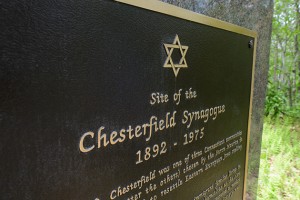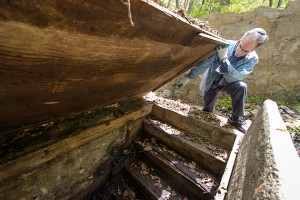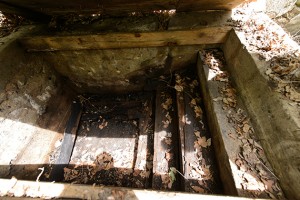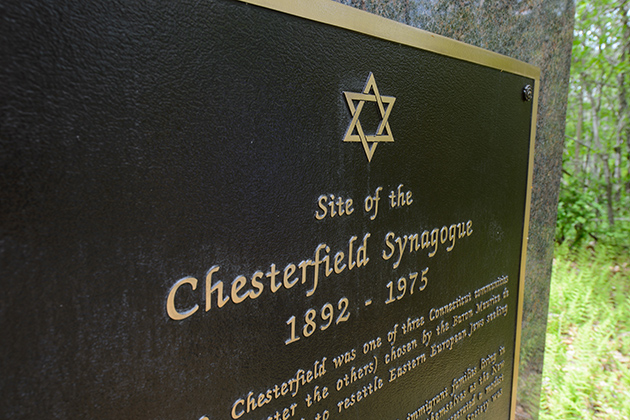Editor’s Note: This story describes the excavation of a remarkable archaeological finding by University of Connecticut researchers in Old Chesterfield, Conn., which is already making waves in the field of Jewish studies. A brief historical survey of late 19th century Jewish agricultural communities in Connecticut follows.

A practically pristine Jewish ritual bath, or “mikveh,” possibly dating back to the late 19th century in this tiny rural community is a one-of-a-kind discovery that will reshape our understanding of a fascinating but often-overlooked part of Jewish life in America, according to University of Connecticut researchers who excavated the site.
A mikveh is an essential part of married life in traditionally observant Jewish households, and this stone and wood-lined structure from Old Chesterfield may be the only mikveh excavated outside a major North American city and may be the only example of its kind at one of the settlements created by a wealthy philanthropist who in the 1890s established farming communities for Jewish immigrants in New Jersey and Connecticut.
The existence of a ritual bath in a rural eastern Connecticut community that barely totaled 500 people at its height throws new light on the religious and social lives of those settlements which were established during a time when American rabbis were lamenting the decline of religious observances like ritual bathing, said Prof. Stuart Miller, Academic Director of the Center for Judaic Studies and Contemporary Jewish Life at UConn and an expert on ritual baths in ancient Israel. Along with State Archaeologist Nicholas Bellantoni, Miller was one of two UConn faculty members overseeing the excavation of the Old Chesterfield site.
“The image many people have of those who belonged to the earliest agricultural communities is that they were largely socialists, and that they weren’t particularly religious,” Miller said. “This is going to enable us to write a chapter of Jewish history which to my knowledge hasn’t been written, one that will deal with the spiritual life of these communities.”
Bellantoni and Miller plan more excavations, but for now, it’s already causing a stir in the field of Judaic Studies. Miller’s proposal to present a paper on the find at the 45th annual Association for Jewish Studies conference in Boston in December has now grown into a full-blown session, with presentations from scholars in the U.S. and Israel.
“This mikveh is very exciting because there’s really nothing else like it in the United States,” Miller said. “It’s intact, it’s magnificent, and from a religious law point of view, it’s a marvel.”
Bellantoni is the Connecticut State Archaeologist and is affiliated both with the Connecticut State Museum of Natural History and Archaeology at UConn along with UConn’s Department of Anthropology. He recently worked with New England Hebrew Farmers of the Emanuel Society (“NHHFES”), comprised of descendants of the original Jewish community of Chesterfield, to secure the designation of the site as the State’s 24th State Archaeological Preserve, which led to its inclusion on the National Register of Historic Places.
The significance of the discovery might have remained unappreciated if it hadn’t been for a fortuitous email from Bellantoni to Miller last Spring.
“You didn’t tell me you had the pool”
As state archaeologist, Bellantoni is as much detective as scholar, being called in to assist in police investigations whenever human remains are discovered, and overseeing the preservation of sites in the state ranging from Native American history to colonial ruins.
In 2012, he was looking into the possibility of excavating the site of the Jewish farming

settlement in Old Chesterfield, a small rural community located in the town of Montville. Roughly 120 years ago, the area was home to a cluster of Russian Jewish families who had relocated from the teeming neighborhoods of New York City’s Lower East Side to make a living as poultry and dairy farmers. Although the community was essentially defunct by World War II, the area still has the remains of the synagogue, the creamery, and what Bellantoni was told had been the home of the ritual slaughterer, a necessity for Jews who observe kosher dietary laws.
While talking with society member Jerry Fischer, Bellantoni realized that both men knew Miller, who had worked for many years on the staff of a major excavation at Sepphoris in Israel, studying ancient Jewish society and especially ritual baths. Bellantoni and Miller had earlier discussed the possibility of teaming up on a dig in Italy, and the archaeologist decided to see if the Judaic Studies professor might be interested in looking around the Old Chesterfield site.
“I’ll be honest. I wasn’t really expecting anything,” Miller said. “I was thinking, ‘I write about and work at sites that are 2,000 years old. What am I going to find in Chesterfield?’”
After showing Miller the ruins of the creamery and the synagogue, Bellantoni led him over to the slope where the ritual slaughterer’s house was. As he saw the high walls, Miller’s curiosity was piqued. He had been told the site might contain a ritual bath, and he was just finishing a book manuscript on Jewish ritual bathing in antiquity. But nothing prepared him for what he saw when he gazed down from the top of the wall into what had been the basement, and saw steps descending into a narrow space.
“I wish someone had taken a picture of the look on my face,” he said. “I think my first words were, ‘You didn’t tell me you had the pool!’”
Miller was aware of a previous excavation of a mikveh in Baltimore from the 1840s, but that looked nothing like what Bellantoni was showing him. This, in fact, didn’t look like anything from Miller’s experience in America: the stone construction reminded him of nothing so much as the mikvehs he had helped excavate in Israel.
“I know what a mikveh is,” he said. “I’ve been in a mikveh. And this doesn’t look anything like a modern mikveh. What I’m expecting is a tiled pool. And suddenly I’m seeing concrete. I’m standing there staring at this and thinking, ‘Where am I? Am I in Sepphoris? Is this really Chesterfield, Connecticut?”
For Bellantoni, Miller’s excitement heightened his own appreciation of a remarkably well-preserved archaeological site, although he didn’t fully understand his colleague’s fascination until Miller began to explain the importance of the find for understanding Jewish life in the United States.
“This was definitely my first experience with Judaic tradition in archaeology,” Bellantoni said. “I mean, how often do you get to work with something like this in Connecticut?”
Water from the heavens or the earth
A mikveh, Miller explained, is vital to an observant Jewish community. According to

Jewish law, husbands and wives, can resume marital relations only after a woman bathes in the mikveh a week after menstruation ends. Although some men bathe in a mikveh, especially before the high holy days, and a mikveh is also needed for conversions to Judaism and for the immersion of new food vessels before their use, the ritual bath’s primary function today is to ensure the monthly renewal of a marriage.
What made this find particularly startling was not only the mikveh’s seemingly archaic construction, but the fact that it existed at all. At the time the Chesterfield community was settled, around 1891, rabbis across the U.S. were decrying the decline of traditional religious practices, especially ritual bathing, Miller said.
“You had various forces that were contributing to these changes,” he said. “You had increasing accommodation and assimilation of East European Jews to American life and the rise in importance of the Reform movement, which didn’t emphasize these types of observance. Instead of building mikvaot, many Jews were either foregoing the practice altogether, or using municipal bath houses in cities, which were problematic from the point of view of religious law,” Miller explained further.
“Mikveh literally means ‘gathering,’ or a collection of water,” he said. “The water in a mikveh has to come from the heavens or from the ground. It has to flow directly to the bath and cannot be interfered with by human hands. You can’t just turn on the tap, fill a bucket with water, and bring it to the mikveh.”
That insight would provide Bellantoni and Miller with a crucial clue on where to dig around the structure, but in the meantime they realized they had to organize an excavation. Miller quickly worked with UConn’s summer school program to put together a field school. Over the course of three weeks last July, the researchers and seven students not only uncovered the remaining structure from years of neglect and forest debris, but also found fascinating remnants of a vanished way of life: children’s toys, household items, cattle bones, even a wagon wheel.
“When they walked away from this community, everything remained just the way they left it,” Bellantoni said. “That’s what makes it such a great research lab. If this community had persisted into the 21st century, all of this would have been changed.”
Using Miller’s knowledge about how mikvaot are built, the team excavated a length of pipe running from the structure up a nearby slope. They theorize that the settlers fulfilled the religious command to use only water from the heavens or the earth by connecting the mikveh to a brook or pond about 200 yards away and relying on gravity to draw the water into the ritual bath.
The researchers also began digging through printed records and sources to try and piece together a picture of life in the Jewish settlement of Chesterfield 120 years ago. The memoir of a woman who had grown up in Chesterfield proved valuable, as did a precious photograph showing the ritual slaughterer’s house, creamery, and synagogue in the same frame. Miller unearthed a “heartrending” letter in Yiddish written around 1915, when the creamery was going bankrupt and members of the community feared it would be sold to non-Jews.
The excavation also yielded some surprises, as when the team discovered the mikveh’s stairs and walls were lined with wood. Miller knew that according to Talmudic law wood was forbidden for use in the construction of mikvaot, but research led him to the discovery of an alternative interpretation of the law followed in many Eastern European communities.
“At every step, we were finding something I didn’t expect to find,” he said.
The next chapter
Much work remains to be done. Aside from Miller’s session at the conference in Boston, he’s giving a talk on the site in West Hartford on June 13th for the Jewish Historical Society of Greater Hartford. Bellantoni is studying the cattle bones found at the site to determine if the animals involved were slaughtered according to Jewish dietary law.
And of course, there’s more excavation to be done, as the two scholars hope to definitively establish the source of water for the mikveh as well as the layout of the room in which it was found. They also plan to turn their attention to the synagogue remains. There are plans for a conference at UConn in 2015, which would be the 125th anniversary of the community’s foundation.
“The excavations in Chesterfield represent an exciting new direction for my colleagues at UConn,” said Prof. Jeffrey Shoulson, Director of the Center for Judaic Studies and Contemporary Jewish Life. “I can think of no more appropriate archeological research to be supported by UConn’s Center for Judaic Studies and Contemporary Jewish Life than their work on this fascinating and forgotten Jewish agricultural community, one of the oldest Jewish communities in the state.”
But for now, there’s the energy and vigor both scholars display as they talk about the remarkable discovery. For Bellantoni, it’s a new side of Connecticut history he hadn’t previously encountered, the Jewish dairy farmers of Old Chesterfield taking their places alongside the Puritans and the Pequots in the rich history of human habitation in the state.
“Having Dr. Bellantoni and Dr. Miller, an internationally renowned interpreter of the history and meaning of mikvaot, and their students excavate the mikveh so carefully last summer has added immensely to our understanding of what life was like then,” said Nancy Savin, a resident of Riverdale, NY, who serves as president of the NHHFES and whose great-great-grandfather led the first settlers to Chesterfield nearly 125 years ago. “It helps us piece together how this small community maintained their traditional religious practices while taking full advantage of the economic and social freedoms they found in Connecticut.”
And for Miller, a New Jersey native who grew up knowing about similar farming communities in that state, it’s the revelation that a lifetime of scholarship in ancient Israel can be applied much closer to home.
“This has opened a window we couldn’t look through before,” he said. “This suggests that we don’t know as much as we think about these communities or about religious life among Jews during this period.”
And in some ways, all those new insights can be traced to a phone call last year.
“It’s funny. Nick and I were talking about working together on an ancient Roman site in Italy,” Miller said. “And here we are on an archaeological dig less than an hour from my house.”
______________________________________________________________
Uncovering Eastern Connecticut’s Jewish history

The one-of-a-kind discovery of a Jewish ritual bath by University of Connecticut professors Stuart Miller and Nicholas Bellantoni invites a new look at one of the most fascinating chapters in the history of the Land of Steady Habits.
In the late 19th century, a wealthy German philanthropist named Baron Maurice de Hirsch whose money came from railroad construction created a fund with the aim of resettling Jewish immigrants from the crowded neighborhoods of New York City’s Lower East Side to agricultural colonies in the northeast.
Most of the participants moved to towns in New Jersey and Connecticut, with a few settling in Massachusetts. In Connecticut, relatively large settlements were established in Colchester, Ellington, Windham, Hebron, and Columbia.
However, Old Chesterfield, in Montville, was the first. The first land for the settlers was purchased in November, 1890 and the community’s synagogue, built for $900, was dedicated on May 6, 1892. Families, mostly of Russian origin, established dairy farms and sold brown eggs, made clothing, and took in summer boarders from New York City, creating what Miller calls “a kind of Catskills in Connecticut.”
The settlers were, initially, a source of benign curiosity for their Yankee neighbors. “The recently settled Russian Jews of Chesterfield are attracting a great deal of attention by their industry,” a Sept. 28, 1891 story in the New London Day reported. “They lost no time after taking up their residence in Chesterfield before they went into business, and not agriculture alone.”
The settlers established a village store (still in business today as a gas station and convenience store), a creamery, a pants factory. “How wide a range their industries cover no one knows, but they keep scratching and no one can tell what they will ultimately grow to,” the Day wrote.
But farm life in Eastern Connecticut was not easy.
“Many of the Russian Jews of the Chesterfield colony are said to be deserting their farms,” the Hartford Courant reported on Feb. 11, 1893. “The suffering there during the cold weather is said to have been very great.”
Of the 28 families found in the settlement in August, 1892, only 15 remained by the autumn of 1894, although the departing families were replaced by newcomers. At its height, before World War I, it had some 50 families, accounting for about 500 people.
But as more families moved to Connecticut, they faced occasional outbreaks of prejudice and bigotry. In 1904, police swarmed Chesterfield and other Jewish settlements, believing that families there were providing shelter to a Jewish fugitive from Colchester named John Marks, although it later emerged that Marks had attempted to flee the state on a ferry boat. The author and journalist Poultney Bigelow wrote an attack on Jewish farmers in 1911, arguing “that the farms of Connecticut are deteriorating because no longer worked by native stock.”
Seventeen years later, during a widespread backlash against immigrants across the U.S., a Hartford Courant headline warned of an “Alien Invasion of Connecticut Farms,” noting that 30 percent of the family farms in the state were “in the hands of a man of foreign birth.”
“What does it mean for the future?” the story asked. “A new poverty-stricken Poland, Galicia, Ireland, or Russia in the pleasant valleys of this state? The Yankee farmer driven to the stones and snows of the North, or, like the Indian before him, obliterated?”
Even a story that favorably portrayed the successes of the farmers traded in ugly stereotypes: “Living down their reputation as mere middlemen who do no labor, they have shown that they can till the soil and make it pay,” ran a 1928 Courant article.
Despite those attitudes, the Jewish farmers did prosper. Most spectacular were the successes of the colony in Ellington, which early in its existence switched from dairy to tobacco during the latter’s height as an industry. But even the poultry and dairy farmers did well: by 1944, the largest single poultry farmer in the state was Max Reisman of Brooklyn, with more than 200,000 broilers and 10,000 layers on his property.
Rural communities everywhere were declining in the first half of the 20th century, though, and Chesterfield was no exception. The creamery went bankrupt in 1915, and by World War II the community was all but deserted, with a few families coming back to the old farmhouses in the summertime. The synagogue was partially destroyed by arson in 1972, and completely destroyed eight years later.
All that remains now are the ruins of the old buildings, a few farmhouses and other properties long since sold to outsiders, and the lovingly tended cemetery not far from the old synagogue. But the experiment in rural living left a lasting impression on the descendants of the settlers, who continue to cherish the memory of the colony even today.
“Two things favored these immigrants,” wrote Micki Savin, granddaughter of Chesterfield settlers, in 1984. “They had complete love of, trust, and hope in God … and they possessed a great joy in their sheer physical existence. Their zest and belief in life infused all they did.”



